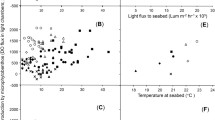Abstract
Based on a review of mostly recent literature for a public lecture, the question is discussed whether we live in a largely “top-down” regulated world rather than one formed “bottom-up” by the resources for plant and animal growth. Of course, the top-down mechanism is predicated by bottom-up production, especially by the plants. Examples for the effects of grazing and predation for the land and the open sea, but including coral reefs, are discussed. The answer to the question posed by the title is affirmative. Ecosystems altered by man and urgent needs for marine conservation are briefly treated.
Similar content being viewed by others
References
Banse K 2002 Steemann Nielsen and the zooplankton; Hydrobiologia 480 15–28
Check E 2006 The tiger’s retreat; Nature (London) 441 927–930
Dalton R 2006 Doing conservation by numbers; Nature (London) 442 12
Devaraj M and Vivekanandan E 1999 Marine capture fisheries of India: challenges and opportunities; Curr. Sci. 76 314–332
Elton C 1927 Animal ecology (London: Sidgewick and Jackson)
Essington T E, Beaudreau A H and Wiedenmann J 2006 Fishing through marine food webs; Proc. Natl. Acad. Sci. USA 103 3171–3175
Guo J 2006 The Galápagos Islands kiss their goat problem goodbye; Science 313 1567
Hairston N G, Smith F E and Slobodkin L B 1960 Community structure, population control, and competition; Am. Nat. 94 421–425
Hilborn R, Branch T A, Erns B, Magnusson A, Minte-Vera C V, Scheuerell M D and Valero J L 2003 State of the world’s fisheries; Annu. Rev. Environ. Resour. 28 359–399
Hodgson G 1999 A global assessment of human effects on coral reefs; Mar. Pollut. Bull. 38 345–355
Hutchings J A and Reynolds J D 2004 Marine fish population collapses: consequences for recovery and extinction risk; BioScience 54 297–309
Jackson J B C 1997 Reefs since Columbus; Coral Reefs (Suppl.) 16 S23–S32
Jackson J B C 2001 What was natural in the coastal oceans? Proc. Natl. Acad. Sci. USA 98 5411–5418
Jackson J B C and 18 others 2001 Historical overfishing and the recent collapse of coastal ecosystems; Science 293 629–637
Knowlton N 2006 Coral reef coda: what can we hope for?; in Coral reef conservation (eds) I M Côté and J D Reynolds (Cambridge: Cambridge University Press) pp 538–549
Leibold M A, Chase J M, Shurin J B and Downing A L 1997 Species turnover and the regulation of trophic levels; Annu. Rev. Ecol. Syst. 28 467–494
Meir A and Tsoar H 1996 International borders and range ecology: the case of Bedouin transborder grazing; Hum. Ecol. 24 39–64
Menge B A 2000 Top-down and bottom-up community regulation in marine rocky intertidal habitats; J. Exper. Mar. Biol. Ecol. 250 257–280
Myers R A and Worm B 2003 Rapid worldwide depletion of predatory fish communities; Nature (London) 423 280–283
Myers R A and Worm B 2005 Extinction, survival or recovery of large predatory fishes; Philos. Trans. R. Soc. London B 360 13–20
Paine R T 2000 Phycology for the mammalogist: marine rocky shores and mammal-dominated communities — how different are the structuring processes?; J. Mammal. 81 637–648
Pauly D 1996 One hundred million tonnes of fish, and fisheries research; Fish. Res. 25 25–38
Pauly D and Maclean J 2003 In a perfect ocean: the state of fisheries and ecosystems in the North Atlantic Ocean (Washington, DC: Island Press)
Pauly D, Watson R and Alder J 2005 Global trends in world fisheries: impacts on marine ecosystems and food security; Philos. Trans. R. Soc. London B 360 5–12
Polacheck T 2006 Tuna longline catch rates in the Indian Ocean: Did industrial fishing result in a 90% rapid decline in the abundance of large predatory species? Mar. Policy 30 470–482
Polis G A 1999 Why are parts of the world green? Multiple factors control productivity and the distribution of biomass; Oikos 86 3–15
Roberts C M, Reynolds J D, Côté I M and Hawkins J P 2006 Redesigning coral reef conservation; in Coral reef conservation (eds) I M Côté and J D Reynolds (Cambridge: Cambridge University Press) pp 515–537
Slobodkin L B, Smith F E and Hairston N G 1967 Regulation in terrestrial ecosystems, and the implied balance of nature; Am. Nat. 101 109–124
Sumaila U R and Pauly D (eds) 2006 Catching more bait: A bottom-up re-estimation of global fisheries subsidies; Fish. Centre Res. Repts 14(6) Vancouver BC: University of British Columbia
Terborgh J, Feeley K, Silman M, Nuñez P and Balukjian B 2006 Vegetation dynamics of predator-free land-bridge islands; J. Ecol. 94 253–263
Van Donk E 2005 Planktonic interactions; developments and perspectives; Proc. Int. Assoc. Theoret. Appl. Limnol. 29 61–72
Ware D M and Thomson R E 2005 Bottom-up ecosystem trophic dynamics determine fish production in the Northeast Pacific; Science 308 1280–1284
Wilkinson C 2006 Status of coral reefs of the world: summary of threats and remedial action; in Coral reef conservation (eds) I M Côté and J D Reynolds (Cambridge: Cambridge University Press) pp 3–39
Worm B and 13 others 2006 Impacts of biodiversity loss on ocean ecosystem services; Science 314 787–790
Worm B, Lotze H K, Hillebrand H and Sommer U 2002 Consumer versus resource control of species diversity and ecosystem functioning; Nature (London) 417 848–851
Author information
Authors and Affiliations
Rights and permissions
About this article
Cite this article
Banse, K. Do we live in a largely top-down regulated world?. J Biosci 32, 791–796 (2007). https://doi.org/10.1007/s12038-007-0080-6
Received:
Accepted:
Published:
Issue Date:
DOI: https://doi.org/10.1007/s12038-007-0080-6




